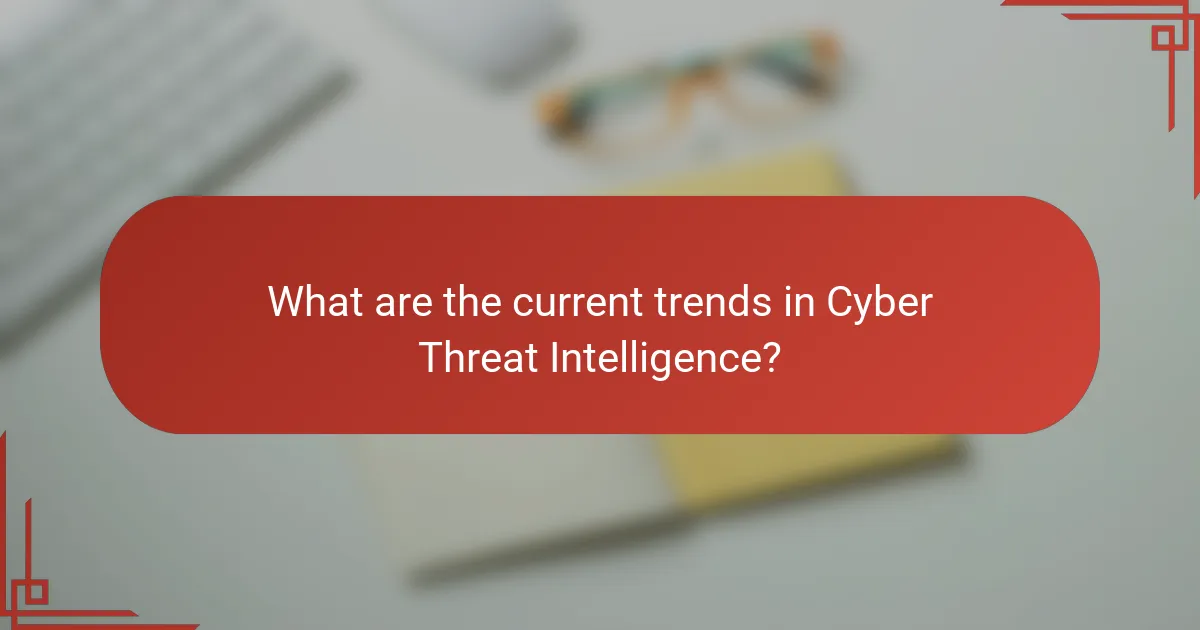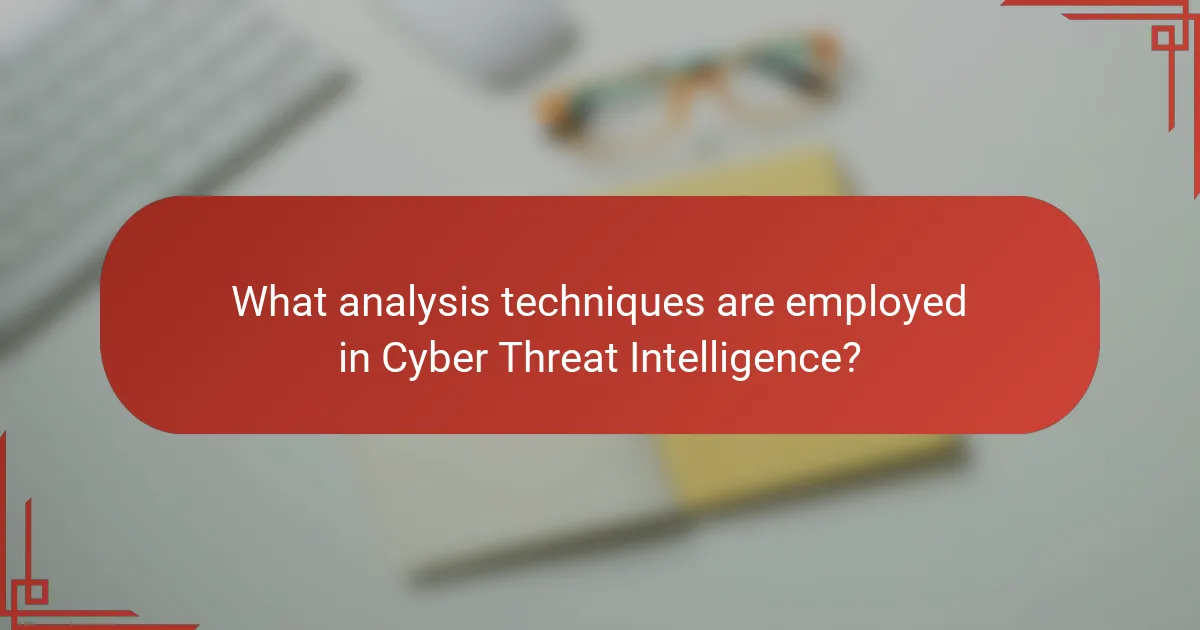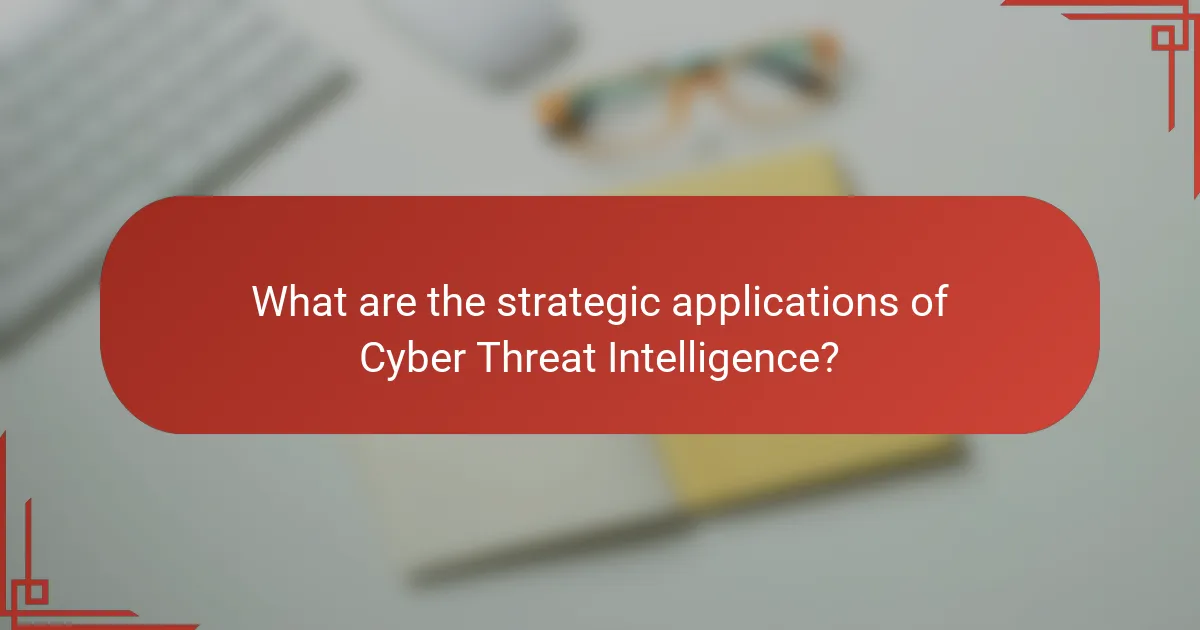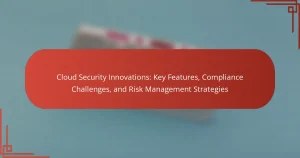Cyber Threat Intelligence (CTI) encompasses the collection and analysis of data related to potential cyber threats, utilizing various sources such as open-source intelligence (OSINT), social media, dark web monitoring, and internal threat data. Current trends in CTI include the integration of artificial intelligence and machine learning to enhance data analysis and threat detection, increased emphasis on threat sharing among organizations, and the adoption of automation to streamline threat intelligence processes. Additionally, organizations are focusing on real-time threat intelligence and personalized solutions tailored to specific risks. Analysis techniques such as threat modeling, data mining, and behavioral analysis are employed to improve understanding and response strategies, ultimately enhancing security posture and informing risk management decisions.

What are the current trends in Cyber Threat Intelligence?
Current trends in Cyber Threat Intelligence include the integration of artificial intelligence and machine learning. These technologies enhance data analysis and threat detection capabilities. Additionally, there is a growing emphasis on threat sharing among organizations. Collaborative efforts improve overall security posture and response times. Another trend is the use of automation in threat intelligence processes. Automation reduces manual workload and increases efficiency. Furthermore, organizations are focusing on real-time threat intelligence. This allows for quicker responses to emerging threats. Finally, there is a shift towards more personalized threat intelligence solutions. Tailored intelligence meets specific organizational needs and risks.
How are organizations adapting to emerging cyber threats?
Organizations are adapting to emerging cyber threats by implementing advanced cybersecurity measures. They are investing in artificial intelligence and machine learning to enhance threat detection. Many organizations are also adopting a proactive approach to cybersecurity by conducting regular risk assessments. This includes identifying vulnerabilities and prioritizing them based on potential impact.
Additionally, organizations are increasing employee training on cybersecurity awareness. This helps in recognizing phishing attempts and other social engineering tactics. Collaboration with cybersecurity firms is another strategy being employed. This allows organizations to leverage external expertise and threat intelligence.
Furthermore, organizations are enhancing their incident response plans to ensure quick recovery from breaches. According to a report by Cybersecurity Ventures, global spending on cybersecurity is expected to exceed $1 trillion from 2017 to 2021. This underscores the growing importance of robust cybersecurity strategies in adapting to evolving threats.
What new technologies are influencing Cyber Threat Intelligence?
Artificial intelligence and machine learning are significantly influencing Cyber Threat Intelligence. These technologies enhance threat detection and response capabilities. AI algorithms analyze vast amounts of data quickly. Machine learning models adapt to new threats over time. Automation tools streamline incident response processes. Blockchain technology improves data integrity and security. Cloud computing enables scalable threat intelligence solutions. These advances allow organizations to stay ahead of evolving cyber threats.
How has the landscape of cyber threats changed in recent years?
The landscape of cyber threats has evolved significantly in recent years. Cybercriminals have increasingly adopted sophisticated techniques. Ransomware attacks have surged, with a 150% increase reported in 2020 alone. Phishing schemes have also become more targeted and convincing. The rise of state-sponsored cyber activities has intensified geopolitical tensions. Additionally, the proliferation of Internet of Things (IoT) devices has expanded the attack surface. According to the Cybersecurity and Infrastructure Security Agency, vulnerabilities in IoT devices are often exploited. Overall, the complexity and frequency of cyber threats continue to rise, necessitating advanced threat intelligence strategies.
Why is Cyber Threat Intelligence important for businesses?
Cyber Threat Intelligence is crucial for businesses as it enhances their security posture. It enables organizations to proactively identify potential threats before they materialize. By analyzing threat data, businesses can mitigate risks effectively. This intelligence guides decision-making and prioritizes security resources. Studies show that organizations utilizing threat intelligence can reduce incident response times by up to 50%. Additionally, it helps in understanding the tactics of cyber adversaries. This understanding allows for better preparedness and resilience against cyber attacks. Ultimately, Cyber Threat Intelligence supports a more informed and strategic approach to cybersecurity.
What role does Cyber Threat Intelligence play in risk management?
Cyber Threat Intelligence (CTI) plays a crucial role in risk management by providing organizations with actionable insights into potential cyber threats. CTI helps identify vulnerabilities and threats specific to an organization’s environment. It enables proactive measures to mitigate risks before they manifest into incidents. By analyzing threat data, organizations can prioritize risks based on their likelihood and potential impact. This informed decision-making process strengthens security postures and aids in resource allocation. Studies show that organizations utilizing CTI report a 30% reduction in successful cyber attacks. Therefore, integrating CTI into risk management frameworks enhances overall cybersecurity resilience.
How does Cyber Threat Intelligence enhance incident response?
Cyber Threat Intelligence enhances incident response by providing actionable insights and context about potential threats. It allows organizations to anticipate attacks and understand threat actor behaviors. This intelligence helps in prioritizing incidents based on risk levels. It also streamlines the response process by equipping teams with relevant threat data. For example, according to the Ponemon Institute, organizations with threat intelligence capabilities experience 12% faster incident response times. Furthermore, it enables proactive defense measures, reducing the overall impact of security incidents. By integrating threat intelligence into security operations, organizations can improve their detection and response strategies significantly.

What data sources are utilized in Cyber Threat Intelligence?
Cyber Threat Intelligence utilizes various data sources to gather relevant information. These sources include open-source intelligence (OSINT), which comprises publicly available data. Social media platforms also serve as valuable sources for threat indicators. Dark web monitoring provides insights into illicit activities and emerging threats. Internal threat data from organizations helps in understanding specific vulnerabilities. Commercial threat intelligence feeds offer curated information on known threats and vulnerabilities. Government and law enforcement reports provide context on cyber incidents and trends. Threat-sharing communities facilitate collaboration and information exchange among organizations. These diverse sources enhance the effectiveness of Cyber Threat Intelligence efforts.
How do open-source intelligence (OSINT) sources contribute?
Open-source intelligence (OSINT) sources contribute by providing publicly available information for analysis. These sources include social media, news articles, and government reports. OSINT enables organizations to gather insights on potential threats. It enhances situational awareness by offering real-time data. Analysts can identify trends and patterns in cyber threats through OSINT. Studies show that 80% of intelligence data comes from open sources. This data aids in risk assessment and decision-making processes. OSINT sources are crucial for proactive cybersecurity measures.
What are the advantages of using OSINT for threat detection?
OSINT provides significant advantages for threat detection. It offers real-time data collection from publicly available sources. This enables organizations to identify emerging threats quickly. OSINT is cost-effective compared to traditional intelligence methods. It reduces the need for expensive proprietary data sources. The vast amount of data available enhances situational awareness. This allows for a more comprehensive understanding of threat landscapes. OSINT can be integrated with other intelligence sources for deeper analysis. Studies show that organizations leveraging OSINT can improve their threat response times significantly.
Which specific OSINT tools are most effective?
The most effective OSINT tools include Maltego, Shodan, and Recon-ng. Maltego excels in link analysis and visualizing relationships between entities. It provides a comprehensive view of data connections, making it valuable for investigations. Shodan specializes in discovering internet-connected devices. It allows users to identify vulnerabilities in various systems. Recon-ng is a powerful web reconnaissance tool. It automates data gathering from multiple sources, streamlining the OSINT process. These tools are widely recognized for their effectiveness in cyber threat intelligence. Their capabilities are supported by user testimonials and industry reviews.
What proprietary data sources are available for organizations?
Proprietary data sources available for organizations include commercial threat intelligence feeds. These feeds provide real-time data on emerging threats. Vendors such as Recorded Future and ThreatConnect offer these services. Organizations can access unique datasets tailored to specific industries. Additionally, private sector partnerships can yield exclusive threat data. These sources often include insights not available in public datasets. Subscription-based models typically govern access to proprietary feeds. This ensures organizations receive timely and relevant information for cybersecurity efforts.
How do commercial threat intelligence feeds work?
Commercial threat intelligence feeds provide organizations with data about potential cyber threats. These feeds aggregate information from various sources, including dark web monitoring, security vendors, and incident reports. They analyze this data to identify patterns and emerging threats. The feeds deliver timely updates to help organizations anticipate and mitigate risks. Many feeds use automated systems to ensure real-time data delivery. Organizations can integrate these feeds into their security systems for enhanced protection. The effectiveness of these feeds is supported by their ability to deliver actionable intelligence. According to a report by Gartner, effective threat intelligence can reduce incident response time by up to 40%.
What are the key features of effective proprietary data sources?
Effective proprietary data sources possess several key features. They ensure high accuracy and reliability of information. This accuracy is critical for making informed decisions in cybersecurity. Additionally, they provide unique insights that are not available from public data. These insights can include specialized threat intelligence or industry-specific data.
Another important feature is timeliness. Effective proprietary data sources deliver information in real-time or near real-time. This allows organizations to respond swiftly to emerging threats. Moreover, they often include comprehensive coverage of relevant threats. This coverage helps organizations identify and mitigate risks effectively.
Security and confidentiality are also crucial attributes. Effective proprietary data sources protect sensitive information to maintain trust. Lastly, they typically offer user-friendly interfaces for data access. This usability enhances the efficiency of data analysis and decision-making processes.

What analysis techniques are employed in Cyber Threat Intelligence?
Cyber Threat Intelligence employs several analysis techniques including threat modeling, data mining, and behavioral analysis. Threat modeling identifies potential threats and vulnerabilities based on an organization’s assets. Data mining extracts patterns and insights from large datasets, helping to identify anomalies. Behavioral analysis examines user and system behavior to detect deviations that may indicate a threat. These techniques enhance the understanding of threats and improve response strategies. For example, a report by Gartner highlights that organizations using threat modeling can reduce incident response times by up to 30%.
How does machine learning enhance threat analysis?
Machine learning enhances threat analysis by automating the detection of anomalies and patterns in large datasets. It enables systems to analyze vast amounts of data quickly and accurately. Traditional methods often struggle with the volume and complexity of data. Machine learning algorithms can identify potential threats in real-time. For instance, they can flag unusual user behavior or network traffic. Research shows that machine learning can reduce false positives in threat detection by up to 50%. This improvement leads to more efficient incident response. Additionally, machine learning models can continuously learn from new data, adapting to evolving threats. This adaptability is crucial in the rapidly changing landscape of cyber threats.
What types of algorithms are commonly used in threat detection?
Common algorithms used in threat detection include anomaly detection, signature-based detection, and machine learning algorithms. Anomaly detection identifies deviations from normal behavior patterns, signaling potential threats. Signature-based detection relies on predefined patterns of known threats to identify malicious activity. Machine learning algorithms analyze vast datasets to improve detection accuracy over time. Research shows that combining these methods enhances overall threat detection capabilities. For instance, a study by Ahmed et al. (2016) in “Computers & Security” highlights the effectiveness of hybrid models that integrate machine learning with traditional methods.
How can machine learning improve predictive capabilities?
Machine learning can improve predictive capabilities by analyzing vast datasets to identify patterns. It enhances the accuracy of predictions by learning from historical data. Machine learning algorithms can adapt to new data over time, refining predictions as more information becomes available. For instance, in cybersecurity, machine learning can detect anomalies that indicate potential threats. According to a report by McKinsey, organizations using machine learning for predictive analytics can see a 20-30% improvement in forecasting accuracy. This capability is crucial for proactive threat detection and response in cyber intelligence.
What traditional analysis methods are still relevant?
Traditional analysis methods that remain relevant include statistical analysis, trend analysis, and historical analysis. Statistical analysis helps in identifying patterns and anomalies in data. It uses mathematical techniques to draw conclusions from data sets. Trend analysis focuses on changes over time, revealing potential future threats. Historical analysis examines past incidents to inform current strategies. These methods are foundational in cyber threat intelligence. They enable analysts to make data-driven decisions. Their continued use is supported by their effectiveness in understanding and mitigating risks.
How does human expertise complement automated analysis?
Human expertise enhances automated analysis by providing contextual understanding and critical thinking. Automated systems analyze large data sets quickly but may lack the ability to interpret nuanced information. Experts can identify patterns that machines might overlook due to their reliance on algorithms. For example, they can assess the credibility of sources, which automated tools may not evaluate effectively. Additionally, human analysts can make informed decisions based on ethical considerations and organizational goals. Research shows that combining human insight with automated processes improves accuracy and relevance in threat detection. A study by the Ponemon Institute found that organizations using both methods experienced a 30% reduction in security breaches.
What are the limitations of traditional analysis techniques?
Traditional analysis techniques often struggle with handling large volumes of data. They may fail to provide real-time insights, which is critical in cyber threat intelligence. Additionally, these techniques can be limited in their ability to detect complex patterns and relationships within data. They typically rely on historical data, which may not reflect current threats accurately. Traditional methods also often lack automation, leading to slower analysis processes. Furthermore, they may not effectively integrate diverse data sources, limiting the comprehensiveness of the analysis. These limitations can hinder timely decision-making in cybersecurity contexts.

What are the strategic applications of Cyber Threat Intelligence?
The strategic applications of Cyber Threat Intelligence (CTI) include enhancing security posture, informing risk management, and supporting incident response. CTI helps organizations identify potential threats before they materialize. By analyzing threat data, companies can prioritize security resources effectively. This proactive approach reduces vulnerabilities and minimizes potential damage from cyber attacks. Furthermore, CTI informs decision-making at the executive level. It provides insights that align security strategies with business objectives. Organizations can also use CTI to comply with regulatory requirements. This ensures they meet necessary security standards. Ultimately, effective CTI leads to improved resilience against cyber threats.
How can Cyber Threat Intelligence inform security policies?
Cyber Threat Intelligence can significantly inform security policies by providing actionable insights into potential threats. It helps organizations identify vulnerabilities and assess risk levels. By analyzing threat data, organizations can tailor their security measures to address specific risks. This proactive approach enhances their ability to prevent attacks. For instance, according to a report by the Ponemon Institute, organizations using threat intelligence experienced a 27% reduction in the average cost of a data breach. Additionally, Cyber Threat Intelligence enables continuous monitoring and updating of security policies based on emerging threats. This adaptability ensures that security measures remain effective against evolving cyber risks.
What best practices should organizations follow for policy development?
Organizations should follow a structured approach for effective policy development. This includes conducting a thorough assessment of existing policies and identifying gaps. Engaging stakeholders is crucial for gathering diverse perspectives. Clear objectives should be established to guide the policy’s purpose. Drafting should involve concise language and clear definitions to avoid ambiguity. Reviewing and revising the draft with input from legal and compliance experts ensures alignment with regulations. Implementing the policy requires effective communication and training for all employees. Finally, organizations should regularly review and update policies to adapt to changing circumstances and emerging threats. These practices enhance the relevance and effectiveness of policies in the context of cyber threat intelligence.
How does threat intelligence shape incident response plans?
Threat intelligence significantly shapes incident response plans by providing actionable insights into potential threats. It enables organizations to anticipate and prepare for cyber incidents. By analyzing threat data, organizations can identify vulnerabilities specific to their systems. This information allows for the prioritization of resources in response strategies. Furthermore, threat intelligence informs the development of detection mechanisms tailored to emerging threats. It also enhances communication protocols within incident response teams. According to the 2021 Verizon Data Breach Investigations Report, organizations using threat intelligence reduce incident response time by 30%. This demonstrates the critical role of threat intelligence in effective incident management.
What role does Cyber Threat Intelligence play in threat hunting?
Cyber Threat Intelligence is crucial in threat hunting. It provides actionable insights that enhance the detection of potential threats. By analyzing data from various sources, threat intelligence helps identify patterns and indicators of compromise. This enables security teams to proactively search for threats before they can cause harm. Threat intelligence also improves incident response by informing hunters about the tactics, techniques, and procedures used by adversaries. Studies show that organizations leveraging threat intelligence reduce their average breach detection time by up to 50%. This data underscores the effectiveness of integrating threat intelligence into threat hunting strategies.
How can organizations develop an effective threat hunting strategy?
Organizations can develop an effective threat hunting strategy by establishing clear objectives and leveraging the right tools. First, define the goals of threat hunting, such as identifying specific threats or vulnerabilities. Next, invest in advanced analytics tools that can process large volumes of data. These tools should provide real-time insights into network activities.
Additionally, organizations must gather threat intelligence from multiple sources. This includes internal logs, external threat feeds, and industry reports. Training skilled personnel in threat detection techniques is crucial. They should understand the latest tactics used by cyber adversaries.
Implementing a continuous feedback loop enhances the strategy. Regularly assess and refine the hunting processes based on findings. According to the 2022 Verizon Data Breach Investigations Report, organizations that actively hunt for threats can reduce the impact of breaches by 50%. This statistic underscores the effectiveness of a proactive threat hunting strategy.
What tools are essential for successful threat hunting?
Essential tools for successful threat hunting include Security Information and Event Management (SIEM) systems, Endpoint Detection and Response (EDR) tools, and threat intelligence platforms. SIEM systems aggregate and analyze security data from various sources. They help in identifying anomalies and potential threats in real-time. EDR tools monitor endpoints for suspicious activities. They provide insights into attacks that may bypass traditional defenses. Threat intelligence platforms offer contextual information about emerging threats. They enhance the ability to prioritize and respond to potential risks effectively. These tools collectively empower security teams to proactively identify and mitigate threats.
What are the best practices for implementing Cyber Threat Intelligence?
The best practices for implementing Cyber Threat Intelligence include establishing a clear strategy, integrating threat intelligence into existing security frameworks, and ensuring continuous monitoring. Organizations should define their specific goals for threat intelligence. This helps in aligning resources effectively. Integrating threat intelligence into security operations enhances incident response capabilities. Continuous monitoring allows for timely updates on emerging threats. Collaboration with external intelligence sources can provide broader insights. Training staff on threat intelligence tools is essential for effective utilization. Regularly updating threat intelligence feeds ensures relevance and accuracy. Engaging in threat intelligence sharing communities can enhance overall security posture.
How can organizations ensure effective collaboration among teams?
Organizations can ensure effective collaboration among teams by implementing clear communication channels. Establishing regular meetings promotes transparency and alignment on goals. Utilizing collaborative tools enhances real-time information sharing. Setting defined roles and responsibilities minimizes confusion and overlap. Encouraging team-building activities fosters trust and rapport among members. Providing training on collaboration techniques equips teams with necessary skills. Monitoring collaboration effectiveness through feedback helps identify areas for improvement. These strategies lead to increased productivity and innovation within teams.
What metrics should be tracked to measure the success of Cyber Threat Intelligence efforts?
Key metrics to track Cyber Threat Intelligence success include incident response time, threat detection rate, and false positive rate. Incident response time measures how quickly an organization reacts to a threat. A shorter response time indicates effective intelligence. Threat detection rate assesses how many threats were identified versus the total threats faced. A higher detection rate signifies better intelligence capabilities. False positive rate tracks the accuracy of threat alerts. A lower false positive rate demonstrates improved precision in threat identification. Additionally, the number of actionable intelligence reports can indicate the relevance and utility of the intelligence produced. Tracking these metrics provides a comprehensive view of the effectiveness of Cyber Threat Intelligence efforts.
The main entity of this article is Cyber Threat Intelligence (CTI), which encompasses the strategies and technologies organizations use to detect and respond to cyber threats. The article explores current trends in CTI, including the integration of AI and machine learning, threat sharing, and automation, highlighting their impact on threat detection and response. It discusses the evolution of cyber threats and the importance of CTI in risk management and incident response, emphasizing the role of various data sources, analysis techniques, and best practices for effective implementation. Additionally, the article outlines how organizations can develop threat hunting strategies and measure the success of their CTI efforts.


